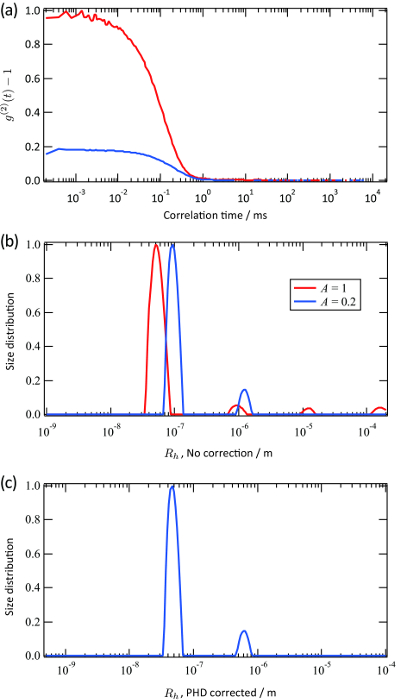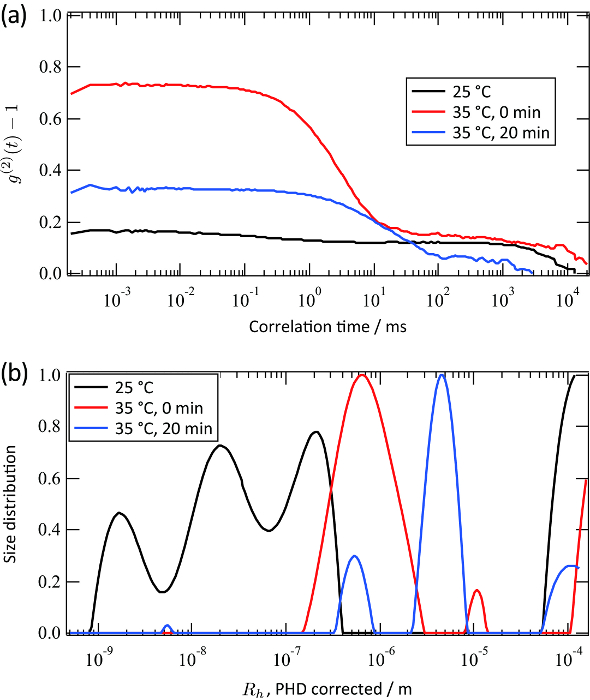Method Article
通过动态光散射显微镜混浊解决方案粒度分布的测定
摘要
一种用于使用动态光散射显微镜浓缩溶液的粒度分布的直接测量协议提出。
摘要
A protocol for measuring polydispersity of concentrated polymer solutions using dynamic light scattering is described. Dynamic light scattering is a technique used to measure the size distribution of polymer solutions or colloidal particles. Although this technique is widely used for the assessment of polymer solutions, it is difficult to measure the particle size in concentrated solutions due to the multiple scattering effect or strong light absorption. Therefore, the concentrated solutions should be diluted before measurement. Implementation of the confocal optical component in a dynamic light scattering microscope1 helps to overcome this barrier. Using such a microscopic system, both transparent and turbid systems can be analyzed under the same experimental setup without a dilution. As a representative example, a size distribution measurement of a temperature-responsive polymer solution was performed. The sizes of the polymer chains in an aqueous solution were several tens of nanometers at a temperature below the lower critical solution temperature (LCST). In contrast, the sizes increased to more than 1.0 µm when above the LCST. This result is consistent with the observation that the solution turned turbid above the LCST.
引言
Particle size is one of the most fundamental properties of colloidal and polymer solutions. Numerous techniques are used to measure the particle size. Particle sizes of 1.0 µm or larger can be measured directly using an optical microscope. For smaller particles, alternative techniques, such as laser diffraction, electron microscopy, or atomic force microscopy, are used2,3. Dynamic light scattering is a commonly-used technique for the measurement of particle size distributions in solutions4. The results obtained using this technique are not derived from images of the particles but from the characteristic time of the fluctuations in scattered light intensity. These fluctuations originate from Brownian motion, which is characterized by a diffusion constant. The size distribution is obtained from the distribution of diffusion constants using the Einstein-Stokes equation. Due to its simplicity, dynamic light scattering is widely used for the routine assessment of solutions, such as paints and food colloids.
Pretreatment is required for most of the techniques used for the particle size measurement of solution samples. In the case of electron microscopy and atomic force microscopy, the sample must be analyzed under vacuum conditions. Therefore, it is difficult to observe the samples in their native forms. Furthermore, for laser diffraction and dynamic light scattering, only diluted samples that are free from multiple scattering and light absorption can be measured. To overcome this difficulty, several new techniques have been proposed for the measurement of dynamic light scattering from undiluted, concentrated solutions, such as cross-correlation spectroscopy5,6, low-coherence dynamic light scattering7,8, diffusing-wave spectroscopy9,10, and differential dynamic microscopy11,12.
We have developed a new apparatus called a dynamic light scattering microscope1. This apparatus enables us to measure turbid samples without dilution by means of a confocal optical system in which multiple scattering is eliminated using a pinhole. However, the measurement procedure and data analysis are slightly more complicated than those of commercially-available instruments. This video explains the measurement procedure and data analysis in detail using the analysis of the temperature-responsive polymer, poly(N-isopropylacrylamide), as an example.
研究方案
1.样品制备
- 温度响应单体的纯化
- 在100毫升甲苯中溶解20g的N- -isopropylacrylamide的(NIPA)。
- 过滤下抽吸该溶液,以消除粉尘。
- 混合用500ml石油醚滤液。
- 放置在反应容器在冰 - 水浴中。
- 搅拌溶液,直到单体被沉淀(通常为30分钟)。
- 过滤下抽吸该溶液,得到沉淀的单体。
- 干燥在减压下(100帕)过夜单体。
- 温度响应性聚合物溶液的制备
- 脱气20毫升去离子水,使用隔膜泵1.0分钟。
- 溶解780.8毫克的纯化NIPA的在9.5毫升脱气和去离子水。
- 放置在反应容器在冰 - 水浴中。
- 屏蔽从反应由覆盖用铝箔装置的光。
- 轻轻搅拌该溶液10分钟,同时通过连接于气瓶用管枪头轻轻引入Ar气的适度流动。
- 添加11.9微升的N,N,N',N'四甲基乙二胺经由微量溶液。
- 搅拌该溶液1.0分钟,同时引入Ar气,如在步骤1.2.5提及。
- 在搅拌的同时将样品,溶解4.0毫克过硫酸铵在0.5毫升脱气和去离子水。
- 混合样品溶液(从步骤1.2.7)和过硫酸铵溶液(来自步骤1.2.8)。
- 搅拌该溶液30秒,同时引入Ar气,如在步骤1.2.5提及。
- 用铝箔覆盖该溶液,并保持它在冰箱(4℃)过夜。
- 坐骑样品的制备
- 将样品溶液的60微升(从步1.2.11)的一腔幻灯片。
- 封面用圆形玻璃盖的解决方案。要小心,不要陷气泡。
- 除去使用微量和实验室湿巾过量的溶液。
- 密封胶水样品。让在室温(通常为6小时)的胶干燥。
- 通过以下步骤1.3.1-1.3.4制备填充有0.1重量%的聚苯乙烯胶乳(100nm的粒径)悬浮另一个滑动。该滑动用作标准。
用动态光散射显微镜2.粒度测量
- 该仪器的优化
- 放置聚苯乙烯胶乳悬浮滑动(从步骤1.3.5)在倒置显微镜的阶段。玻璃盖面应朝下。
- 放置在检测器的前面的光束阻尼器(雪崩光电二极管和自相关)。
- 施加激光束(固态激光器,λ= 488纳米,30毫瓦,连续波)到样品通过物镜(10×)。的反射光的一部分穿过显微镜的发射镜,并通过CCD照相机观察到安装在显微镜( 图1)的侧端口。
- 调整物镜的高度由从低到高的位置移动物镜的高度,以设定在样品悬浮液的焦点。在此过程中,被反射的图像被聚焦三次:在盖玻璃的表面上,在玻璃盖和样品之间的界面,并在样品和空穴载玻片之间的接口。设置第二个和第三个点之间的焦点。
- 通过改变激光功率衰减的散射光强度。
- 通过在检测器的前面取出光束阻尼器引进的散射光进入检测器。此单元测量的光强的时间相关性。
- 设置一个针孔(φ= 50微米)betwEEN显微镜和检测器来实现共焦的效果。调节针孔的位置在检测器以最大化光强度。
- 通过经由计算机启动所述相关器的操作测量30秒散射光强度的时间相关函数。测得的相关函数通常表示为g(2)(T) - 1,其中t是相关时间4和
 。这里,I(t)是在时间t和(•••)T是时间平均散射光强度。衰减时间将约为0.1毫秒。
。这里,I(t)是在时间t和(•••)T是时间平均散射光强度。衰减时间将约为0.1毫秒。 - 调整着力点,获得了广泛的时间相关函数的初始幅度( 克 (2)(T = 0) - 1)。
注:初始振幅强烈影响的反射光的量。通过移动焦点拖ARD玻璃盖和样品,反射光的量增加之间的接口。对于强光散射,如聚苯乙烯胶乳,初始振幅可以从0改变为1。然而,这是难以设置接近1为更常见的聚合物溶液的初始振幅,因为反射光的强度远高于散射光的。 - 应用Laplace逆变换(使用约束正计划CONTIN 13,14)所获得的时间相关的函数来获取大小分布函数。在将初始振幅设定为小于0.2的情况下,水动力半径的分布函数会显示约100纳米,这是实际的半径(详见讨论)两次的尖峰。
- 样品测量
- 设置了阶段温度至25℃。
- 将带有聚NIPA(PNIPA)SOLUT准备了幻灯片离子显微镜的阶段(步骤1.3.4)。
- 通过以下步骤2.1.4-2.1.8测量散射光强度的时间相关函数。如果初始振幅是大于0.2,通过以下步骤2.1.9调整焦点,以使时间相关函数的初始振幅小于0.2。一个小幅度的初始简化了分析。
- 将舞台温度35℃,等到溶液变浑浊。的PNIPA溶液的低临界溶液温度(LCST)是32℃下15。
- 通过以下步骤测量时间相关函数2.1.4-2.1.8。如果可行的话,调整焦点的位置,使时间相关函数小于0.2的初始振幅。为混浊的解决方案,它们的初始振幅趋于增加,因为散射光的强度增大而反射光的保持不变。
- 应用拉普拉斯逆transformati上所获得的时间相关函数,得到的粒度分布的功能。请注意,实际的大小为一半的情况下所获得的值,其中初始振幅是小于0.2。
结果
在不同的焦点进行测定,示于图2(a):为聚苯乙烯胶乳悬浮液散射光强度的时间相关函数(50纳米粒子半径)。这些相关的功能被转换成由逆拉普拉斯变换的流体力学半径的分布函数(参照图2(b)和(c)项 )。采用相同的步骤,在25℃下分别得到的PNIPA溶液的流体动力学半径的时间相关函数和分发功能和35℃。 图3(a)和(b)示出的散射光强度的时间相关函数和下面的PNIPA溶液(25℃)和上述(35℃)的LCST的相应尺寸分布函数。大小分布函数是由逆拉普拉斯变换之后所获得的偏差校正。低于LCST的平均流体动力学半径为几十纳米,这是典型的聚合物溶液。与此相反,在高于LCST的流体动力学半径为约1.0微米。这一结果与以下事实的溶液是高于LCST混浊一致。红色和蓝色线条图3表示后立即得到的,该溶液后20分钟分别变为混浊,PNIPA溶液的粒度分布。 如图3(b)清楚地表明,聚集的生长。

图1.动态光散射显微镜的示意图。针孔(PH),光束分离器(BS),偏振器(POL)和雪崩光电二极管(APD)。 请点击这里查看一个更大的版本这个数字。

图2.为聚苯乙烯胶乳悬浮液的代表性结果。 (a)用于在聚苯乙烯胶乳悬浮液中的散射光强度的时间相关函数。标称半径为50nm,浓度为0.1%(重量)。两个数据集分别从不同的散射点获得。 ( 二 ),( 三 )相应大小分布为聚苯乙烯胶乳悬浮液的逆拉普拉斯变换获得的功能(一个)。红线对应的时间相关函数的初始振幅是约1.0,和蓝线对应于一个初始幅值即约0.2。横轴没有(B)和(c)考虑部分外差(PHD)的影响,计算的时候A << ; 1. 请点击此处查看该图的放大版本。

图3为一个PNIPA溶液代表性的结果。 (a)用于所述PNIPA溶液散射光强度的时间相关函数。 (b)在通过(a)的逆拉普拉斯变换获得的PNIPA溶液通讯尺寸分布函数。横轴计算考虑局部外差的每个数据集的效果。黑线表示在25℃下获得的数据。红线代表刚后溶液变混浊而获得的数据(35℃)。蓝线代表红色线的20分钟测量后获得的数据。/54885/54885fig3large.jpg"目标="_空白">点击此处查看该图的放大版本。
讨论
时间相关函数的初始振幅在很大程度上依赖于焦点, 如图2(a)中 。这看似矛盾的事实,即溶液是均质的(除了在界面处的薄层)8。在最初的振幅的这种变化是由于在反射光的量的变化。偏差理论16预测的初始振幅,A中 ,散射光强度,I s和反射光强度,I R,满足下式1

这个公式表明,I R变得越大,越小A变得。因此,A通过设置靠近接口的焦点位置降低。表观扩散常数D A CAÑ通过在单分散的解决方案的情况下,拟合时间相关函数来获得:

哪里 。这里,n是溶剂(水,1.33)的折射率,θ是散射角(180°),和λ是光(514.5nm的)的波长。因为我们施加散射几何学,q的值是固定的。然而,这点是通过使用不同波长的光解决。请注意,任何类型的连续波激光源的可用来构造对DLS显微镜。由于小照射量,相干因子17估计为0.99以上,是可以忽略不计。对于多分散溶液,由逆拉普拉斯变换获得的D A的分布函数。偏差次eory还预测,D A是不一样的实际扩散常数D。这两个扩散常数满足以下公式:
。这里,n是溶剂(水,1.33)的折射率,θ是散射角(180°),和λ是光(514.5nm的)的波长。因为我们施加散射几何学,q的值是固定的。然而,这点是通过使用不同波长的光解决。请注意,任何类型的连续波激光源的可用来构造对DLS显微镜。由于小照射量,相干因子17估计为0.99以上,是可以忽略不计。对于多分散溶液,由逆拉普拉斯变换获得的D A的分布函数。偏差次eory还预测,D A是不一样的实际扩散常数D。这两个扩散常数满足以下公式:

扩散常数D被转换成使用爱因斯坦-Stokes方程4中的流体动力学半径R H。当A = 1,这种关系变得D A = D。在这种情况下,数据转换过程是相同的,对于共同的动态光散射。在图2(b)中所示的红色线对应于这种情况。与此相反,这种关系变为D A = 0.5 D钮 A的极限→0,因此,大小估计为两倍的实际大小为大时,A是小的(实际上,小于0.2),如图所示由图2(b)的蓝线。如果我们知道A是显著小,横轴可以移动, 如图2(c)所示 。原则上,我们可以D A转换成D代表A的任意值。在实践中,然而,最好是设定为比0.2的初始振幅小,由于简单的近似D A〜0.5ð成立。
动态光散射显微镜技术的突出特点是使用PNIPA解决方案演示。 PNIPA的下面和高于LCST构象已经使用小角中子散射15,18被广泛地研究。相比之下,动态光散射尚未用于PNIPA的LCST以上的分析,因为它的浊度19。这个问题是由动态光散射显微镜解决, 如图3(a)和(b)中 。这些聚集体的尺寸为几&#181;米,这不能由任一小角X射线/中子散射或常规的光散射技术获得。使用该系统的时间分辨的测量的温度变化过程中得到的聚集过程的信息。
动态光散射显微镜的缺点也被在图3中示出。为低于LCST的结果,时间相关函数强烈地受到本灰尘的极少量的(黑线在图3中)的影响。例如,该时间相关函数不完全衰减,即使在1.0秒的数量级相关时间。这是因为该装置(约1.0微米)的照射体积比照射与通常的动态光散射装置(大约100微米)显著小。在的情况下的散射光的强度较弱,信号被噪音掩盖,比如导致由s商场的量在溶液中的灰尘。因此,在如图3(b)中所示的三个峰可能不具有定量的重要性虽然尺寸的一般顺序是有意义的。另外,这样的弱散射体可以通过常规的动态光散射装置进行测定。
我们已经证明,在动态光散射显微镜使我们能够用相同的设置测量透明和混浊样本。由于样品中的光路长度短,该技术可以适用于强的光吸收的样品,如碳纳米管悬浮液20。此外,由于其高的空间分辨率,该技术可以适用于生物细胞。其应用到生物学,这种方法也可与其它成像技术,如荧光和拉曼成像相结合。因此,我们认为,在动态光散射显微镜为广泛研究领域的有力工具。
披露声明
The authors have nothing to disclose.
致谢
This work has been financially supported by Grants-in-Aid for Scientific Research from the Ministry of Education, Culture, Sports, Science, and Technology (No. 25248027 to M.S.).
材料
| Name | Company | Catalog Number | Comments |
| N-isopropylacrylamide, 98% | Tokyo Chemical Industry Co., Ltd. | I0401 | |
| toluene, 99% | Wako Pure Chemical Industries, Ltd. | 201-01876 | |
| petroleum ether, distillation temperature 30 ~ 60 °C | Wako Pure Chemical Industries, Ltd. | 169-22565 | |
| N,N,N',N'-tetramethylethylenediamine, 99% | Sigma | T9281 | |
| ammonium persulfate, 98% | Sigma | 248614 | |
| polystyrene latex suspension, 1 wt% | Duke Scientific Corporation | 3500A | |
| argon | Koike Sanso Kogyo Co., Ltd. | purity > 99.999 vol.% | |
| cavity slide | Matsunami Glass Ind.,Ltd. | 83-0336 | |
| inverted microscope | Nikon Instech Co., Ltd. | ECLIPSE Ti-U | |
| Thermo Plate | Tokai Hit CO.,Ltd | TP-108R-C | |
| Solid-state laser | Coherent | OBIS 488LX | |
| avalanche photodiode | ALV-GmbH | ALV-High Q.E. Avalanche Photo Diode | |
| correlator | ALV-GmbH | ALV-5000/EPP |
参考文献
- Hiroi, T., Shibayama, M. Dynamic Light Scattering Microscope: Accessing Opaque Samples with High Spatial Resolution. Opt. Express. 21, 20260-20267 (2013).
- Barth, H. G., Flippen, R. B. Particle Size Analysis. Anal. Chem. 67, 257-272 (1995).
- Liu, Y., Wang, Z., Zhang, X. Characterization of supramolecular polymers. Chem. Soc. Rev. 41, 5922-5932 (2012).
- Berne, B. J., Pecora, R. Dynamic Light Scattering with Applications to Chemistry, Biology and Physics. , Dover Publications, Inc. (2000).
- Phillies, G. D. J. Experimental demonstration of ruultiple-scattering suppression in quasielastic-light-scattering spectroscopy by homodyne coincidence techniques. Phys. Rev. A. 24, 1939-1943 (1981).
- Phillies, G. D. J. Suppression of multiple scattering effects in quasielastic light scattering by homodyne crosscorrelation techniques. J. Chem. Phys. 74, 260-262 (1981).
- Ishii, K., Yoshida, R., Iwai, T. Single-scattering spectroscopy for extremely dense colloidal suspensions by use of a low-coherence interferometer. Opt. Lett. 30, 555-557 (2005).
- Xia, H., Ishi, K., Iwai, T. Hydrodynamic Radius Sizing of Nanoparticles in Dense Polydisperse Media by Low-Coherence Dynamic Light Scattering. Jpn. J. Appl. Phys. 44, 6261-6264 (2005).
- Maret, G., Wolf, P. E. Multiple light scattering from disordered media. The effect of brownian motion of scatterers. Z. Phys. B. 65, 409-413 (1987).
- Pine, D. J., Weitz, D. A., Chaikin, P. M., Herbolzheimer, E. Diffusing wave spectroscopy. Phys. Rev. Lett. 60, 1134-1137 (1988).
- Cerbino, R., Trappe, V. Differential Dynamic Microscopy: ProbingWave Vector Dependent Dynamics with a Microscope. Phys. Rev. Lett. 108, 188102(2012).
- Lu, P. J., et al. Characterizing Concentrated, Multiply Scattering, and Actively Driven Fluorescent Systems with Confocal Differential Dynamic Microscopy. Phys. Rev. Lett. 108, 218103(2012).
- Provencher, S. W. A constrained regularization method for investing data represented by linear algebraic or integral equations. Comp. Phys. Comm. 27, 213-227 (1982).
- Provencher, S. W., Stepanek, P. Global analysis of dynamic light scattering autocorrelation functions. Part. Part. Syst. Charact. 13, 291(1996).
- Takata, S., Norisuye, T., Shibayama, M. Small-angle Neutron Scattering Study on Preparation Temperature Dependence of Thermosensitive Gels. Macromolecules. 35, 4779-4784 (2002).
- Pusey, P. N., van Megen, W. Dynamic Light Scattering by Non-Ergodic Media. Physica A. 157, 705-741 (1989).
- Chu, B. Laser Light Scattering. 2nd Ed. , Academic Press. (1991).
- Shibayama, M., Tanaka, T., Han, C. C. Small-Angle Neutron-Scattering Study on Poly(N-Isopropyl Acrylamide) Gels near Their Volume-Phase Transition-Temperature. J. Chem. Phys. 97, 6829-6841 (1992).
- Tanaka, T., Sato, E., Hirokawa, Y., Hirotsu, S., Peetermans, J. Critical Kinetics of Volume Phase Transition of Gels. Phys. Rev. Lett. 55, 2455-2458 (1985).
- Hiroi, T., Ata, S., Shibayama, M. Transitions of Aggregation States for Concentrated Carbon Nanotube Dispersion. J. Phys. Chem. C. 120, 5776-5782 (2016).
转载和许可
请求许可使用此 JoVE 文章的文本或图形
请求许可探索更多文章
This article has been published
Video Coming Soon
版权所属 © 2025 MyJoVE 公司版权所有,本公司不涉及任何医疗业务和医疗服务。